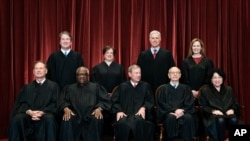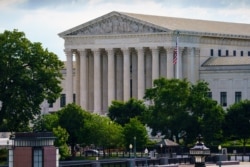If there were any doubts that the U.S. Supreme Court has moved decidedly to the right following three key appointments by former President Donald Trump, the six conservative justices on the bench put those to rest last Thursday.
On the final day of the high court’s nine-month term, the six Republican-appointed jurists, over scathing dissents from their liberal colleagues, issued ringing endorsements of causes championed by Republicans in a pair of rulings.
The first ruling pitting the six conservatives against the three liberals upheld two Arizona voting provisions that Democrats say will make it harder for voters to cast their ballots and will undermine racial discrimination deterrents under the 1965 Voting Rights Act.
In the second opinion, the justices, again by a vote of 6 to 3, struck down a California requirement that its supporters say is key to keeping tabs on fundraising by nonprofit organizations.
For certain, contrary to early liberal fears and predictions, the six conservative jurists, including the three Trump appointees, did not always vote as a bloc during the term.
Indeed, in several consequential cases, including one involving the fate of the Affordable Care Act, the conservatives — in particular Chief Justice John Roberts and Trump appointees Brett Kavanaugh and Amy Coney Barrett — joined the progressive wing to hand down narrowly decided rulings. That alliance blocked a third try to overturn Obamacare since the health insurance law was passed in 2010.
These decisions fueled the notion among court watchers that three moderate conservatives and the three liberal jurists had formed a “minimalist majority” in an attempt to avoid deep ideological divisions within the court. But Thursday’s decisions blew that notion wide open, said Steve Schwinn, a professor of law at University of Illinois Chicago.
“Today's opinions were just raw six-three divisions on the court where the conservative supermajority really exercised its power and muscle,” said Schwinn, who runs a constitutional law blog.
Thanks to Trump’s three critical court appointments — Kavanaugh, Barrett and Neil Gorsuch — this was the first term in decades in which conservatives held a 6-3 supermajority on the Supreme Court. Roberts, Samuel Alito and Clarence Thomas are the other three conservatives.
John Malcolm, a legal fellow at the conservative Heritage Foundation in Washington, said that while conservatives scored several big wins this term, liberal fears about a radical transformation of the Supreme Court were not borne out.
“The liberal wing of the court can still prevail, but they now have to attract two justices rather than one,” Malcolm said. “And they certainly proved their ability to do that on more than one occasion in very significant cases.”
Nevertheless, on politically controversial issues such as abortion and gun rights, the justices will likely remain sharply divided, Schwinn added.
Richard Briffault, a Columbia University law professor, said it’s still too early to say just how the conservative supermajority will impact the law. “This court is only getting going,” Briffault said.
Here is a look at six key rulings of the Supreme Court during the 2020-2021 term. Three were passed unanimously or by broad majorities. Three others were 6-3 conservative rulings.
Religious Freedom vs LGBTQ Rights — Pitting religious freedom against LGBTQ rights, this case involved the city of Philadelphia’s refusal to work with a Catholic charity after the charity stopped certifying gay couples as prospective foster parents. The charity, Catholic Social Services, and two foster parents sued the city, claiming Philadelphia’s refusal violated the U.S. Constitution’s clause on the “free exercise” of religion. The nine justices unanimously agreed with the nonprofit, but they issued a narrow ruling in the case.
Obamacare Survives Again — This case marked the third time Republicans went to the Supreme Court in more than a decade to challenge Obamacare, former President Barack Obama’s signature health insurance plan. As in the past two cases, the justices upheld the law, this time by a vote of 7 to 2. But they skirted the larger question of whether the whole law was made unconstitutional after Congress eliminated a penalty for refusing to buy health insurance under the plan. Instead, the justices ruled that the plaintiffs in the case — Texas and 19 other states as well as several individuals — did not have a legal right to sue because they could not show they were harmed by any government related to the law.
Cursing Cheerleader Wins — At issue in this closely watched case was a Pennsylvania school’s decision in 2017 to suspend a 14-year-old student from a cheerleading squad after she posted profanity and a vulgar gesture on Snapchat. Brandy Levi went to court claiming her suspension violated her First Amendment right to free speech. The court agreed, by a vote of 8-1, even as it held that schools have some interest in regulating off-campus speech. Civil liberties advocates hailed the ruling as a victory for free speech.
Unions vs. Property Rights — The first major 6-3 conservative decision of the term, the ruling invalidated a California regulation that allows union organizers to enter the grounds of an agricultural business for the purpose of recruiting union members. Two fruit businesses challenged the law, claiming it gave unions the right to use their property without paying “just compensation.” The six conservatives sided with the challengers. Liberals denounced the decision as “anti-union,” but to conservatives it was a ruling in favor of property rights, Malcolm said.
Arizona Voting Rights — This was another 6-3 conservative ruling in one of the most closely watched cases of the term. At issue were two Arizona voting provisions: a ban on voting in the wrong precinct and a ban on third-party collection of ballots from voters unable to vote in person. Democrats challenged the provisions, contending they disproportionately burdened minority voters in violation of the 1965 Voting Rights Act. The six conservative justices disagreed, upholding the Arizona provisions as legal under the VRA. Schwinn said the decision will make legal challenges to restrictive voting rules “much more difficult.”
Big Donor Disclosure — This case involved a California policy that requires nonprofit organizations to disclose their major donors to the state attorney general. Two conservative advocacy organizations challenged the requirement as a violation of the First Amendment, arguing that it would have a chilling effect on their donors. The six conservative justices agreed with the challengers in what Malcolm described as a “big win” for conservatives. Voting rights advocates said the decision will undercut efforts to keep tabs on “dark money” groups that raise and spend millions of dollars without disclosing their donors.













